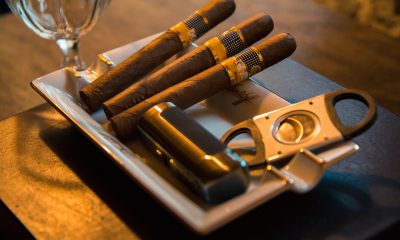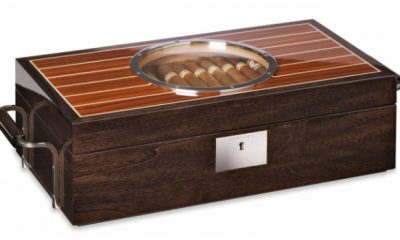Guy Stuff
Cigars: The Facts and The Myths

The world of cigars is one that is steeped in as much culture and history as it is in misconception and misquoted facts. From some of the sillier myths, like Cuban cigars being rolled between the legs of virgins (this was actually reported as true by a an exaggerative journalist of the late 1950’s) to some facts that just might pique your interests, like the cigar being Mark Twain’s famous muse for getting the words down on the page.
Today, a cigar can represent a number of things. In film, the cigar brings a certain seedy, underbelly mobster-esque sophistication, while in real life it can mark a certain pedigree of success and commodore among businessmen and women. As with anything, with knowledge comes appreciation and with appreciation comes new levels of enjoyment. Below are four of the most pervasive myths as well as four interesting facts that you might not have known before. So whether you’re looking for a good conversation starter next time you are with a smoking budding or you are simply looking to educate yourself about your hobby the information below will be right up your alley.
The Myths
1. White Ash
This myth began to surface sometime around the late 80’s and early 90’s. It is believed that cigars of the highest pedigree burn off a bone-white ash. This characteristic was rather curious as any seasoned cigar smoker would know that Cuban cigars, the reigning king in the cigar world, do not even exhibit this quality.
While some still hold tight to this assumed tell-tale sign of quality, the actual reason for this white ash is rooted more in science than it is in cigar hierarchy. White ash is in fact a by-product of soil composition, particularly, a soil that is abundant in phosphorus and calcium.
As a result, you get cigars that are made from tobacco leaves out of Ecuador, where calcium in the soil is plentiful, emitting a white ash. On the other hand you have cigars out of Cuba that don’t have that same soil composition, that will never emit that same white ash.
Instead of looking for an all-white or even an all-black ash, it’s instead a good idea to be on the lookout for an ash that has more of a range of gray tones.
2. Cuban Cigars are the Most Potent
While Cuban cigars do carry the weight of being one of the most esteemed cigars in the world, they are by no means the most potent, but then again, that relies on your definition of potent. Potent can be equated to a cigar that is robust with flavor, aromas or even high amounts of nicotine. Cuban cigars, like all other cigars can be made in a variety of methods.
Most cigar experts believe that this myth has stemmed from the enigmatic qualities that the Cuban cigar has undergone since the embargo of 1962, but some say there is a little truth behind the myth. Those that have been able to get their hands on an undisputed Cuban cigar say that some of the cigars from this region are being made with tobacco that isn’t quite through its fermentation process. The result is a bolder smoking experience. Potent to some, desired by others.
3. The Flavor of a Cigar Comes from the Wrapper
The myth that the majority of a cigar’s flavor comes from the wrapper leaf is one that is a bit exaggerated. The leaves that wrap a cigar can and do influence the flavors that come from a cigar but to definitively say that 70 to 80 percent of the flavor comes from the wrapper is a bit of a stretch.
To debunk this one you only need to look as far as the filler. For instance, if the wrapper of the cigar is a shade leaf and the filler is something along the lines of a full-bodied and bold tobacco, the wrapper is going to have a very minor role in the shaping of the flavor. On the other hand, if the wrapper is a broadleaf and the filler is mild, the wrapper will play a large part in the taste. Do your research on some of your favorite cigars. Manufacturer websites will almost always disclose this information for you.
4. Pre-Embargo Cuban Tobacco in the United States Simply Does Not Exist
The title says it all. If you come across an expensive cigar that states it is made from pre-embargo tobacco chances are, you’re getting duped. While it is true, some manufacturers did stock up on this tobacco before the embargo went through, I can almost assuredly say that it has since been used. Raw tobacco from this long ago would also be completely useless. After a certain amount of time, tobacco that hasn’t been rolled and stored at a proper temperature will rot and decay.
However, there are still some cigars that are being circulated throughout the United States that hail from pre-embargo Cuba. These cigars often rear their heads at high-end auctions and are worth quite a bit of cash.
The Facts
1. The Etymology
The word cigar, just like the cigar itself, has undergone quite a few changes since it was first documented by Columbus in 1492. The word we say today is in fact a derivation from the Spanish word cigaro which is coincidentally another derivation from the Mayan word siyar which stood for non-other than tobacco.
2. Growing Countries
While tobacco is grown in the United States (about 16 of them to be exact) the US isn’t known for the crème de la crème of tobacco. Instead, the majority of the tobacco that is put into our cigars heralds from countries like Brazil, Cameroon, The Dominican Republic, Mexico and even the Philippines.
3. Seed Size
The old adage, “from small things big things come” holds perfectly true for the tobacco plants. In fact, more than a 1000 tobacco seeds are capable of fitting in one thimble.
4. Rolling a Cigar
Rolling a cigar is no easy task. In fact, the event is made even trickier when the cigar falls outside of the traditional ring gauges and shapes. Cigar varietals like torpedoes, pyramids and perfectos all take a lot of effort and skill to role just right.
A roller on the top of their game can push out about 120 cigars a day.
Luzzie Normand is a cigar enthusiast and freelance blogger. When she isn’t blogging, Luzzie enjoys writing her own serial comic books and slinging ink at tattoo shops.




















Francesco
April 23, 2013 at 11:05 am
Nice post.
I’m always game to enjoy a nice cigar.